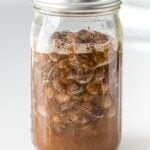How to Make Yeast Water
Yeast water is made by capturing and cultivating wild yeast found on fruit. When left to ferment, this water can be used to create a wild yeast starter that's perfect for all kinds of baking!
Servings: 4
Calories: 78kcal
Equipment
Ingredients
- 250 g filtered water - see Notes if using tap water
- 100 g raisins - See Notes about preservatives
- 4 g white sugar
Instructions
- Weigh all your ingredients with a kitchen scale. Check the label on your raisins to make sure they're free of sulfur dioxide (a preservative) and any type of oil coating. These can inhibit yeast growth. If possible, use organic raisins.
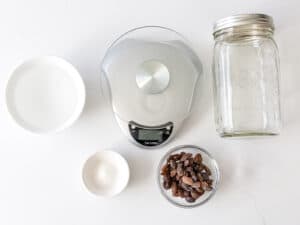
- Add all the ingredients to a clear jar with an airtight lid. Shake it until the sugar dissolves and place it in a warm place out of direct sunlight. The raisins should lay at the bottom of the container.
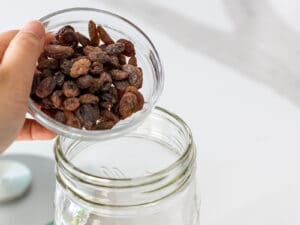
- Vigorously shake the mixture for 3 seconds morning and evening for the next 3 to 8 days or until you start to see the raisins float in the water. The length of time will depend on yeast activity and temperature.It's very important to open and close the lid before AND after every shake. This ensures you don't have excessive gas build up in your container which can cause the lid to pop off! Keep the lid sealed at all other times.
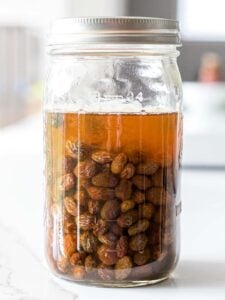
- After a few days, you should start to notice signs of fermentation in the yeast water. The water should be cloudy and there should be tiny bubbles around the raisins and along the sides of the container. The raisins will be suspended in the water instead of laying at the bottom of the container.
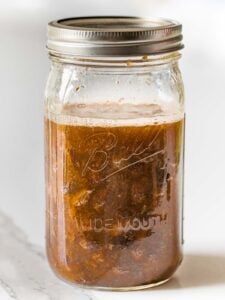
- The yeast water is ready to use once the raisins float to the top. (Note: Yeast consumes sugar as food and then produces carbon dioxide as a byproduct. When the raisins float, it's a sign that there's enough yeast activity to generate gas build up. This means it's ready to strain and use in a wild yeast starter.)

- Strain the raisins in a mesh strainer and gently press out any remaining liquid. You can either discard the raisins or use them for baking.

- Store the yeast water in an airtight container and keep it in the fridge for up to two months. You can use this liquid to create a natural yeast starter or add it to bread recipes. Be sure to mix it well before adding it to any recipe as there will be settlement.
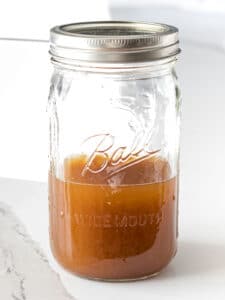
Notes
- Read about how to create a starter using yeast water.
- This recipe yields 414g of yeast water.
- If using tap water, fill your container with water and let it sit out uncovered for 24 hours. This will dechlorinate the water.
- Raisins - if your raisins have preservatives or an oil coating, soak them in hot water for 15 minutes before using. Otherwise, it's best to use organic, preservative free raisins. Check the ingredients to see that raisins are the only ingredient. If you see it contains sulfur dioxide, that is a preservative.
- The time it takes for the raisins to float depend on the amount of yeast present on the skin of the raisins and also the ambient temperature. To speed things up, place it in a warmer area of the house but away from direct sunlight.
- Be sure to keep the lid closed at all times except for when opening it before and after every shake.
- When you make a new batch, save a ¼ cup of the previous yeast water and add it to your new batch. It will speed things up and will be ready to use a lot sooner!
Nutrition
Calories: 78kcal | Carbohydrates: 21g | Protein: 1g | Fat: 1g | Saturated Fat: 1g | Sodium: 10mg | Potassium: 206mg | Fiber: 2g | Sugar: 1g | Vitamin C: 1mg | Calcium: 7mg | Iron: 1mg
